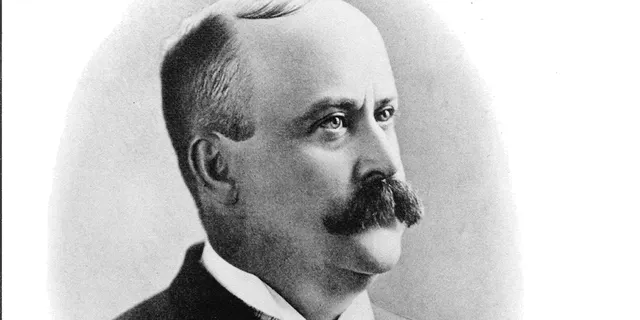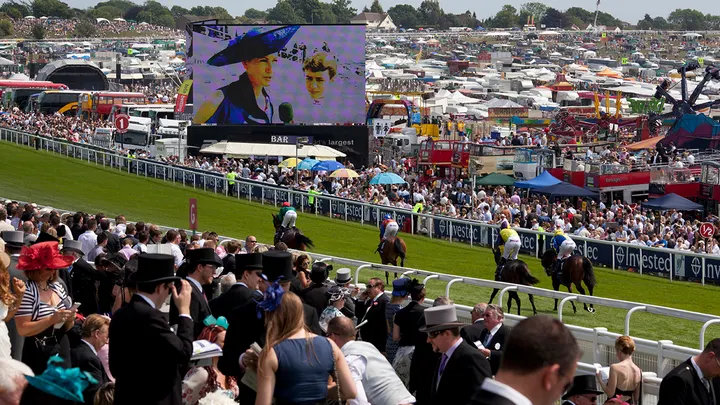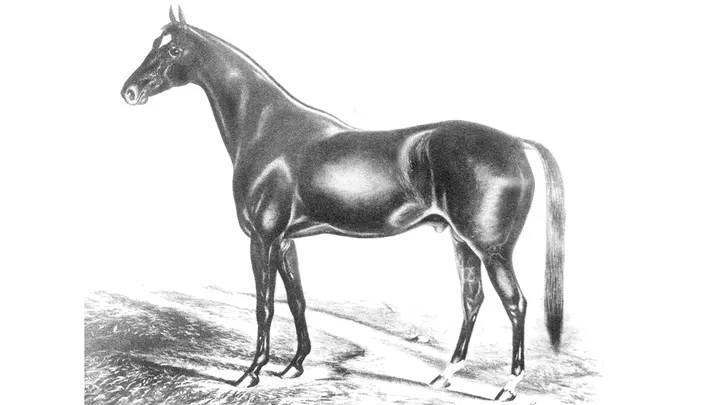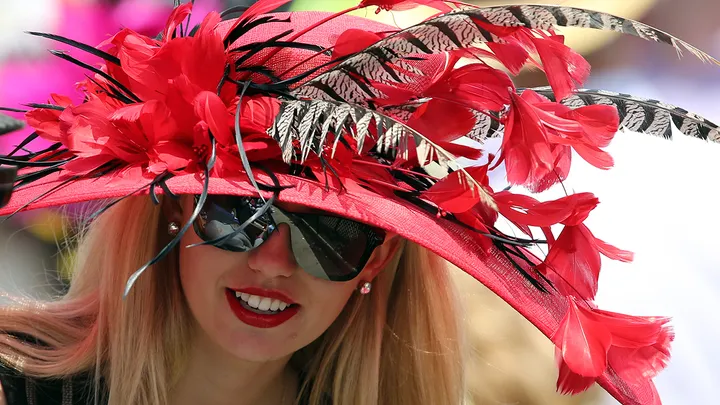Story Of The American Who Created The Kentucky Derby, Meriwether Lewis Clark Jr., Born Of Pioneers

Seeds of horse race planted by grandson of famous American explorer in aftermath of Civil War
The Kentucky Derby is a global sports spectacle and, in the eyes of many, America’s definitive sporting tradition.
The event was forged, almost incredibly, by two of the great epic events in United States history: the triumph of the Lewis and Clark Expedition and the tragedy of the Civil War.
The bluegrass seeds of the world’s most famous horse race were planted by a fascinating man with a uniquely American heritage.
His name is Meriwether Lewis Clark Jr.
He’s the founder of both the Kentucky Derby, which was has been run every year since 1875, and the Louisville Jockey Club, later known as Churchill Downs.

“Clark’s impact on the Kentucky Derby and on horse racing in general cannot be overstated,” Chris Goodlett, senior director of curatorial and education affairs at the Kentucky Derby Museum, told Fox News Digital.
“He was extremely important, to say the least.”
“Clark’s impact on the Kentucky Derby and on horse racing in general cannot be overstated.” — Chris Goodlett, Kentucky Derby Museum
If the name Meriwether Lewis Clark sounds familiar, it should.
The founder of the Kentucky Derby is the grandson of one of the great heroes of American history, famed explorer William Clark.
He was named for Clark’s equally legendary partner, Meriwether Lewis.

The Lewis and Clark Expedition traversed the vast, rugged, unrecorded American interior from St. Louis to the Pacific Ocean and back between 1804 and 1806. The journey made both men national heroes.
“The direct link to the Kentucky Derby comes through William Clark,” James J. Holmberg wrote for the Filson Historical Society in Louisville.
“His love of horses was passed onto his son, Meriwether Lewis Clark.”
The elder Meriwether Lewis Clark raised dozens of horses and kept detailed records of them. Clark Jr. grew up in a culture shaped by dauntless pioneers and horsemen.

The Kentucky Derby also sprang from the desire of Kentucky’s horse-racing community to recover from the devastation of the Civil War.
Clark was at the forefront of an effort that helped unite the nation through love of horses, sports, spectacle — and rowdy, old-fashioned good times.
Pioneer’s namesake
Meriwether Lewis Clark Jr. was born on Jan. 27, 1846 in Jefferson County, Kentucky, to Meriwether Lewis and Abigail Prather (Churchill) Clark.
His family called him Lutie.
His father, Clark Sr., was the oldest child of William Clark, the Army officer, explorer and later governor of the Missouri Territory. Grandpa Clark died eight years before Lutie was born.

The bond shared by William Clark and Meriwether Lewis is evident in the most intimate tribute imaginable: Clark named his firstborn son after his partner in exploration.
Lewis never had children.
Clark Sr. served as a U.S. Army officer in the Mexican-American War, then as a general in the Confederate army in the Civil War. Clark Jr. was of military age during the conflict but his service, if any, appears unknown.
Kentucky played a unique role in America’s deadliest conflict. It was a slave state, but never seceded from the Union.
“The direct link (from Lewis and Clark explorations) to the Kentucky Derby comes through William Clark.” — Filson Historical Society in Louisville.
It also drew particular attention from President Abraham Lincoln, who was born in Kentucky in 1809.
“I think to lose Kentucky is nearly the same as to lose the whole game,” Lincoln wrote in a letter to Sen. O.H. Browning of Illinois in 1861.

The Union did not lose Kentucky. Nor did it gain it. The commonwealth was ravaged by internal conflict amid the wider national bloodshed.
Kentucky’s economy was devastated by the war, including its cherished horse-racing industry, which dates back to the arrival of the first pioneers in the late 1700s.
“Meriwether Lewis Clark Jr. himself had no known racing interest until 1872, when a group of horse breeders, concerned with the decline of horse-racing in Louisville, approached him with a plan to save it,” reports the Filson Historical Society.
He built the track on 80 acres leased from his uncles John and Henry Churchill.
He visited Europe, where he was impressed by the spectacle and the quality of the Epsom Races in Britain.
He returned with a plan to revive Kentucky’s horse-racing industry with an equally glamorous spectacle.
“He built the track on 80 acres leased from his uncles John and Henry Churchill, just three miles south of downtown Louisville,” Churchill Downs reports in its online history.

Clark raised money by selling membership subscriptions to the track, the Louisville Jockey Club.
“With 320 membership subscriptions sold for $100 each, Clark raised a total of $32,000,” Churchill Downs notes.
“A group of horse breeders, concerned with the decline of horse-racing in Louisville, approached Clark with a plan to save it.”
“This profit was used to construct a clubhouse, grandstand, Porter’s Lodge and six stables on site for the opening of the track. Throughout the years, the initial structures still stand, but the racetrack has continued to grow and modernize.”
‘Grand success’
The first Kentucky Derby was held on May 17, 1875. It was one of three races at the Louisville Jockey Club that day.
“The opening day of the Kentucky Derby, at Louisville, on Monday, was a grand success,” raved the Interior Journal of Stanford, Kentucky.

The derby apparently debuted with many of the traditions still cherished today, according to historian Goodlett.
Among them: racing fans lubricated by Kentucky bourbon fashioned into aromatic mint juleps while dressed in their celebratory finery.
“The attendance was upward of 12,000,” the New Orleans Republican reported. “The grandstand being thronged by a brilliant assemblage of ladies and gentlemen.”
Aristides, a majestic chestnut colt, galloped to victory against a field of 14 other thoroughbreds “in the fastest time ever made by a three-year-old,” according to another contemporary account.

Aristides was owned by H. Price McGrath; jockeyed by Oliver Lewis, a 19-year-old African American (both men from Kentucky); and trained by Ansel Williamson, a former slave and legendary American horseman.
Williamson was born into slavery in Virginia in 1806. He was sent to work at famed Woodburn Stud in Louisville in 1864 in the midst of the Civil War.
It was there that Williamson heroically saved Asteroid, Kentucky’s most famous thoroughbred of the era, from Quantrill’s Raiders, a notorious band of Confederate horsemen that included among its members Frank and Jesse James.
Aristides, the first Kentucky Derby winner, was trained by Ansel Williamson, a former slave and legendary American horseman.
Quantrill’s Raiders scoured Kentucky for horses in the desperate final months of the war when they came across Woodburn Stud — seeking its most legendary horse.
“At the stable one of the guerrillas asked for Asteroid by name,” author William P. Magnum II wrote for The Filson Club Historical Quarterly in 1996.

“Because it was dark, the shrewd trainer Ansel pulled a switch and substituted an inferior horse. The substitution was a brave act because the guerrillas demanded the horses at gunpoint.”
Williamson had “saved the best horse in the stable,” Woodburn Stud owner Robert A. Alexander reportedly said.
Black jockeys and trainers such as 1875 champions Lewis and Willamson, many of them former slaves, dominated the early days of the Kentucky Derby, winning 15 of the first 28 races and training six of the first 17 winners, notes the Kentucky Commission on Human Rights.
Tragic death
Meriwether Lewis Clark Jr. never lived to see the Run for the Roses blossom into the stunning spectacle it is today.
He died by his own hand, shooting himself in Nashville, Tennessee, on April 22, 1899. He was 53 years old.

There is a haunting precedent to his death.
Clark’s namesake, explorer Meriwether Lewis, reportedly killed himself by gunshot, too, also in Tennessee, in 1809. The cause of his death has been disputed.
Clark Jr. was reportedly suffering great financial hardship, spurred by massive losses in the stock market crash and the Panic of 1893.
The signature twin spires were added to Churchill Downs in 1895.
The Derby itself has suffered lean years after the promise of 1875.
“The track was not in good financial shape, there were short fields and it wasn’t certain what the Derby would become,” said Goodlett.

The shortest field came in 1892, when only three horses ran in the Kentucky Derby. (In 1905, only three horses ran as well, after two others scratched.)
In 1894, Clark surrendered leadership of the event. New management took over, solidified the event and expanded the infrastructure.
The signature twin spires were added to Churchill Downs the following year, 1895.
The traditional song “My Old Kentucky Home,” which was written in 1852, only slowly became a part of the lore of the Kentucky Derby. Its first confirmed appearance was at the 47th race in 1921.
Twenty of the world’s fastest racehorses typically compete in the Kentucky Derby, with no fear of a dismal field of three.
More than 150,000 people pack Churchill Downs each year. Millions more gather around TVs and at parties from coast to coast, many dressed in their Derby finest, as if they’re at Churchill Downs.

The winning horse will earn $1.86 million this year.
“We know what the Kentucky Derby has become — an incredible sporting and cultural event not just in the U.S. but around the world,” said Goodlett.
“It wouldn’t have happened if we didn’t have what Clark started.”
But, the historian added, “the scope of the Kentucky Derby today was never known to him.”





